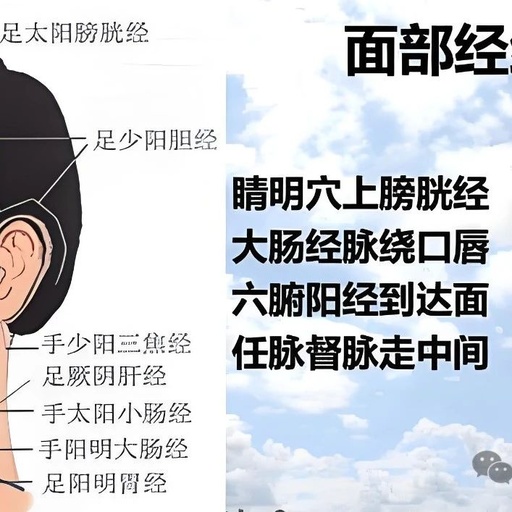Inheriting the legacy of Qi Huang, a public account with substance and warmth.
Ai Yu Xiang Tang
The meridians consist of three Yin and three Yang: the three Yang are Yangming (阳明), Shaoyang (少阳), and Taiyang (太阳), while the three Yin are Taiyin (太阴), Jueyin (厥阴), and Shaoyin (少阴). The concept of the three Yin and three Yang often feels too abstract and difficult to remember during our studies. To facilitate the understanding and memorization of the distribution of the three Yin and three Yang meridians in the human body, we attempt to use the meridian lines of a globe and the areas of the body that receive sunlight when facing the sun to comprehend and remember the concept of the three Yin and three Yang in the meridians.“The Distribution of the Three Yin and Three Yang Meridians in the Human Body”On a globe, the meridian lines and latitude lines are arranged in a grid; to accurately locate a specific area, we only need to provide two values: longitude and latitude. Points along the same meridian receive sunlight at the same time. The twelve meridians in the human body are also distributed longitudinally, and we can imagine these meridians as meridian lines on the human body. Assuming we stand naturally upright, with our arms relaxed and hanging down, and our feet together with toes pointing forward, what areas receive direct sunlight when we face the sun? These areas include the head, face, mouth, nose, neck, throat, chest, abdomen, and the front of the upper limbs (arms, hands) and lower limbs (thighs, calves, feet). In Traditional Chinese Medicine (TCM), these areas are specifically referred to as Yangming. When we turn to face the sun sideways, the areas receiving direct sunlight change to: the side of the head, ears, side of the body, outer side of the upper limbs, and outer side of the lower limbs. These areas are collectively known as Shaoyang. When we turn our back to the sun, the areas illuminated by sunlight include: the back of the head, neck, back, waist, and the back of the upper and lower limbs. These areas are referred to as Taiyang. Besides these areas, we find that there are some regions where sunlight cannot directly reach, primarily the inner sides of the upper and lower limbs. TCM divides these areas into three parts from front to back, naming them Taiyin, Jueyin, and Shaoyin. In other words, areas where sunlight can reach are termed Yang, further divided into Yangming, Shaoyang, and Taiyang; areas where sunlight cannot reach are termed Yin, further divided into Taiyin, Jueyin, and Shaoyin. This forms the basic concept of the three Yin and three Yang. TCM further refines this concept based on the hands and feet into Hand Three Yin, Hand Three Yang, Foot Three Yin, and Foot Three Yang. Merely defining these Yin and Yang corresponding areas in such vague terms makes it inconvenient for learning and mastery, so ancient practitioners used a “line-drawing” method to provide a more intuitive representation of these areas, thus forming the well-known twelve meridians. Before the Northern Song Dynasty, doctors primarily followed the acupuncture points specified in the Tang Dynasty’s Huangdi Ming Tang Jing for acupuncture treatment. However, due to the turmoil at the end of the Tang Dynasty, the Huangdi Ming Tang Jing was lost, leading to a lack of standards for later acupuncture point selection. To re-establish national standards for acupuncture points, in the fourth year of the Tian Sheng era (1023 AD), Emperor Renzong of Song ordered the highest medical institution, the Medical Officer Institute, to compile the Newly Cast Bronze Human Acupuncture Chart. This task was assigned to Wang Weiyi, a renowned physician of the Northern Song Dynasty who served as a medical officer during the reigns of Emperors Renzong and Yingzong. After three years of effort, he completed the new national standard for acupuncture points, the Newly Cast Bronze Human Acupuncture Chart. To facilitate preservation, it was engraved on five stone tablets. Emperor Renzong believed that “transmitting the heart is not as good as seeing it, and writing is not as good as presenting the form.” Thus, he ordered the casting of acupuncture bronze figures based on the Newly Cast Bronze Human Acupuncture Chart. The design of the acupuncture bronze figures was overseen by Wang Weiyi, and skilled craftsmen from across the country were organized to cast them. In 1027, two identical acupuncture bronze figures were completed, later referred to as the “Song Tian Sheng Acupuncture Bronze Figures.” Throughout subsequent dynasties, various acupuncture bronze figures were created based on the distribution of TCM meridians and acupuncture points, primarily for teaching acupuncture medicine and examination purposes. During examinations, mercury was injected into the bronze figures, and the body surface was covered with yellow wax to completely obscure the meridian points. Candidates could only rely on experience to insert needles. If they accurately hit the acupuncture point, mercury would flow out from the point. This unique phenomenon was recorded in medical history as “mercury flows out when the needle is inserted.” The “Song Tian Sheng Acupuncture Bronze Figures” are the earliest known acupuncture bronze figures in China and even the world, pioneering the use of bronze figures as human models for acupuncture teaching.“The Principle of the Correspondence Between Meridians and Organs”The above concepts of the hand and foot three Yin and three Yang primarily focus on the division of surface areas. However, TCM emphasizes the organs in the human structure. So, is there a specific relationship between the so-called five Zang (organs) and six Fu (bowels) and the three Yin and three Yang? First, let’s look at the five Zang and six Fu. The five Zang are where essence is stored, where the spirit resides, also known as the five spirit organs. The spirit prefers tranquility and fears disturbance. Therefore, the five Zang should be still and not move. When still, the spirit is at peace; when in motion, the spirit is disturbed, which is Yin in nature. The six Fu are the places for the transformation and transportation of food and fluids. The human body requires nourishment from fresh nutrients daily while also needing to expel metabolic waste promptly. Thus, the six Fu require movement and smoothness, as “the six Fu function through smoothness.” Therefore, the six Fu should be active and not still. When active, food and fluids are digested, and the body is nourished; when still, food and fluids stagnate, leading to various diseases, which is Yang in nature. The Yin-Yang attributes of the Zang and Fu clarify the corresponding relationship with the surface Yin and Yang: the five Zang correspond to the “Yin” areas on the inner sides of the limbs, while the six Fu correspond to the “Yang” areas on the front, outer, and back sides of the limbs. Further examining the five Zang, the lungs and heart are located in the thoracic cavity, above the diaphragm, and are close to the hands; the liver, spleen, and kidneys are located in the abdominal cavity, below the diaphragm, and are close to the feet. Compared to the lungs and heart, the lungs are above and external, while the heart is below and internal. Between the lungs and heart, there is a sac-like structure that protects the heart, known as the pericardium. Thus, from top to bottom, the three organs are arranged as follows: lung, pericardium, heart. If we correspond the anatomical positions of these three organs to the inner sides of the upper limbs, we form the following relationships: lung – Hand Taiyin; pericardium – Hand Jueyin; heart – Hand Shaoyin. For the liver, spleen, and kidneys, the spleen and liver are generally at the same horizontal level, while the kidneys are below. Similarly, if we correspond this anatomical position with the Foot Three Yin meridians, we can derive the following relationships: spleen – Foot Taiyin; liver – Foot Jueyin; kidney – Foot Shaoyin. Finally, regarding the six Fu (excluding the Sanjiao), their anatomical positions are all in the abdominal cavity, below the diaphragm. Comparing the relationships between the five Zang and the hand and foot meridians, we can see that the six Fu should correspond to the Foot Yang meridians. In terms of specific positions, the stomach is above, the gallbladder is in the middle, and the bladder is below; the large and small intestines belong to the same pathway as the stomach. Therefore, the relationships between the six Fu and the Foot Three Yang meridians are as follows: stomach – Foot Yangming; gallbladder – Foot Shaoyang; bladder – Foot Taiyang. The large and small intestines, in terms of physical structure, belong to the same family as the stomach, and in terms of meridians, they also belong to the Foot Yangming meridian; clinical treatment of large and small intestine issues primarily starts from this meridian. The remaining large and small intestines correspond with the Sanjiao, matching the Hand Yangming meridian with the large intestine, the Hand Shaoyang meridian with the Sanjiao, and the Hand Taiyang meridian with the small intestine. Thus, we form the classic theory system of the twelve meridians corresponding to the twelve Zang and Fu that we see today. The Hand Yangming Large Intestine Meridian has a point called Hand Sanli, which is effective for treating gastrointestinal diseases, and when used in conjunction with the well-known Foot Sanli, the effect is even better. The Suwen Linglan Mijian Lun states: “The small intestine is the official of receiving and transforming, from which substances are excreted.” The function of the small intestine in transforming food into the refined substances needed by the body determines the treatment scope of the small intestine meridian. The Lingshu Jing Mai Pian states that the small intestine meridian is “responsible for diseases arising from fluids.” “Fluids” include menstruation, breast milk, leukorrhea, semen, and what modern medicine refers to as glandular secretions, such as gastric juice, pancreatic juice, prostatic fluid, and synovial fluid. Therefore, any diseases related to “fluids” can first be explored through the small intestine meridian. The Sanjiao governs the body’s overall Qi mechanism and Qi transformation, facilitating the movement of water and fluids. The Hand Shaoyang Sanjiao meridian primarily prevents and treats diseases such as tinnitus, migraine, facial muscle spasms, constipation, and colds.“Distribution Patterns of the Twelve Meridians in the Limbs, Head, Face, and Trunk”The distribution of the twelve meridians refers to their scattering within specific areas of the human body. To understand and analyze the distribution patterns of the twelve meridians, we divide the human body into three different parts: the trunk, head and face, and limbs for analysis.1. LimbsThe Yin meridians are distributed on the inner sides of the limbs, while the Yang meridians are distributed on the outer sides. The general distribution pattern is that the Taiyin and Yangming meridians are at the front edge; the Jueyin and Shaoyang meridians are along the midline; and the Shaoyin and Taiyang meridians are at the back edge. However, the distribution of the meridians on the inner side of the lower limbs below 8 cun (寸) above the inner ankle does not conform to this pattern: the Foot Jueyin Liver Meridian is at the front, the Foot Taiyin Spleen Meridian is in the middle, and at 8 cun above the inner ankle, the two meridians cross, returning to the norm, as shown in the table below.
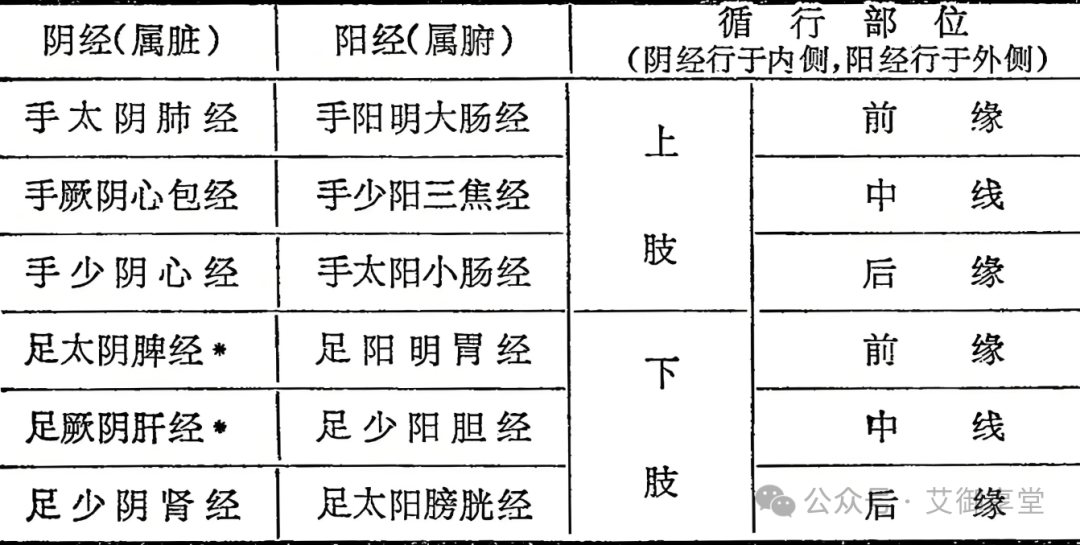
For the above table, we need to further clarify the following three points: (1) Regardless of the upper and lower limbs, the general distribution pattern is: on the inner side from front to back, it is “Tai Jue Sha” (太阴、厥阴、少阴); on the outer side from front to back, it is “Yang Sha Tai” (阳明、少阳、太阳). (2) Regarding the intersection of the Foot Jueyin Liver Meridian and the Foot Taiyin Spleen Meridian at 8 cun above the inner ankle, below 8 cun, the Foot Jueyin Liver Meridian is at the front, and the Foot Taiyin Spleen Meridian is at the midline. Above 8 cun, the Foot Taiyin Spleen Meridian returns to the front, and the Foot Jueyin Liver Meridian returns to the middle. This is related to the starting points of the Foot Jueyin Liver Meridian and the Foot Taiyin Spleen Meridian. The starting point of the Foot Taiyin Spleen Meridian is at the hidden white point at the inner side of the big toe. What is the hidden white point? It is the boundary where the color of the foot’s dorsum is deep (red) and the color of the sole (palm) is light (white). At this boundary, there is a margin known as the hidden white point. There is also a boundary line on the palm and back of the hand. The starting point of the Foot Taiyin Spleen Meridian is at the inner side of the big toe, where the two big toes are close together. The Foot Jueyin Liver Meridian starts at the tuft of hair behind the big toe’s nail. Thus, the Spleen Meridian is behind, and the Liver Meridian is in front. Therefore, at 8 cun above the inner ankle, the two meridians need to cross, allowing the Foot Taiyin Spleen Meridian to be in front, the Foot Jueyin Liver Meridian in the middle, and the Foot Shaoyin Kidney Meridian behind, following the general pattern. (3) The term 8 cun above the inner ankle does not refer to a fixed measurement; the length of 8 cun varies from person to person. In reality, it is merely a ratio, artificially divided, and each person can measure it with their own hand, known as “finger to body cun.” A common method of measurement is: from the inner ankle, two horizontal fingers (6 cun), plus two thumbs (2 cun).
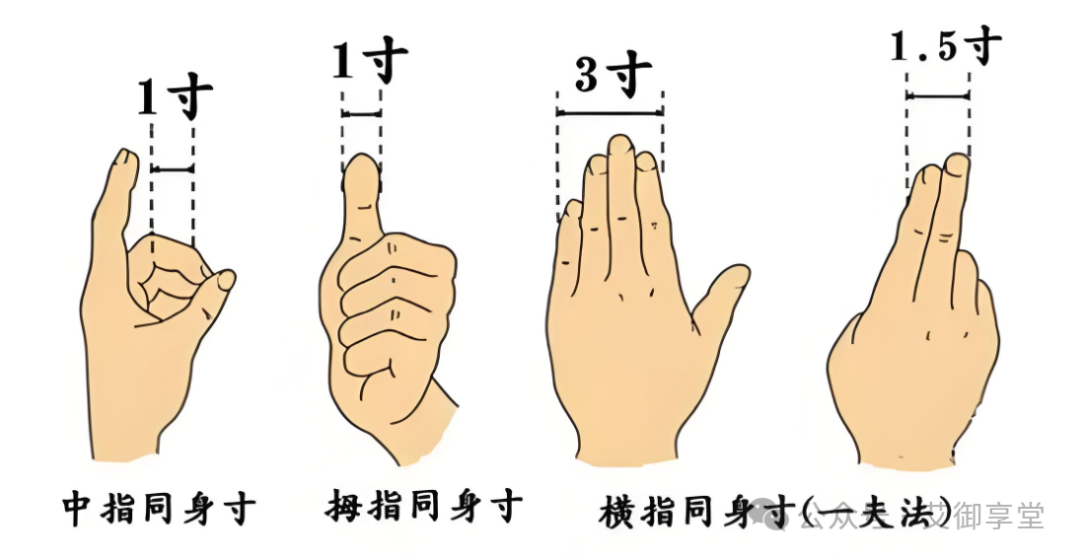
2. Head and Face“The head is the meeting of all Yang.” The head and face primarily distribute the Hand and Foot Yang meridians. Among them, the Hand and Foot Yangming meridians run along the face and forehead; the Hand and Foot Shaoyang meridians run along the sides of the head; and the Hand and Foot Taiyang meridians run along the cheeks, top of the head, and back of the head.
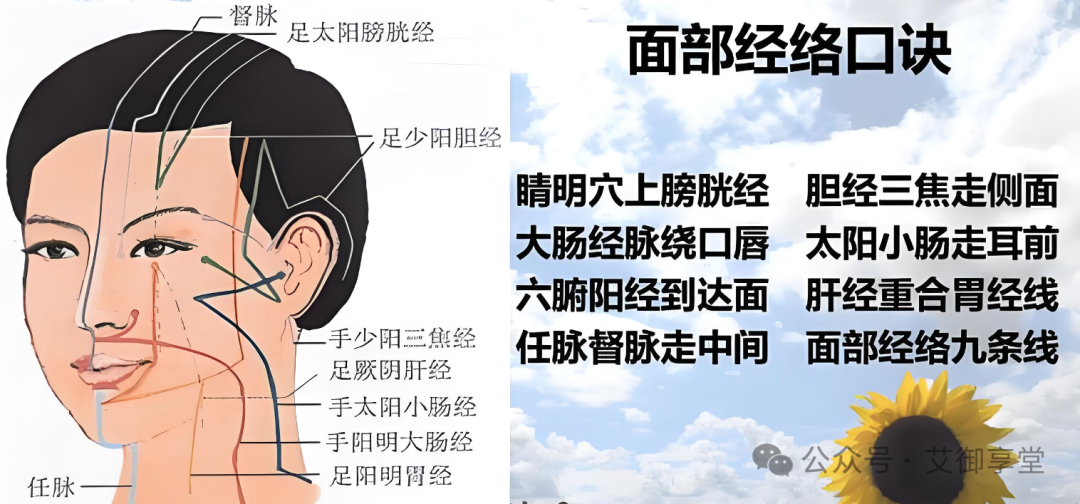
We refer to the head as “the meeting of all Yang.” The Yang energy in the head is abundant, making the head and face resistant to cold, which is an explanation of life phenomena in TCM. Dividing the head into front, middle, and back sections, the Yang is most abundant in the front, where the Yangming energy is strongest, hence it is distributed in the front; the Taiyang energy is next to Yangming, so it is distributed in the back; and the Shaoyang has the least Yang energy, thus it is distributed in the middle. Besides the front, middle, and back, there is also a part at the top of the head, known as the vertex. The vertex is where the Foot Jueyin Liver Meridian is distributed. As mentioned earlier, Yin meridians do not ascend to the head; indeed, the Yin meridians do not reach the head’s surface, but the Foot Jueyin Liver Meridian specifically circulates internally, connecting to the eyes and exiting at the forehead, ascending to meet the Governing Vessel at the vertex, thus its energy reaches the vertex. We include this part to address clinical issues; later, when studying Chinese herbs, we will learn that Wu Zhu Yu treats vertex pain, dry vomiting, and salivation. Its therapeutic effects are related to vertex headaches and dry vomiting, so the vertex belongs to the Foot Jueyin Liver Meridian. Understanding the distribution patterns of the twelve meridians in the head and face has significant implications: it guides diagnosis and treatment. We can diagnose corresponding meridian diseases based on different areas of the head or headaches in different locations. For example, pain in the forehead can be diagnosed as Yangming headache. Toothache belongs to the Yangming meridian, with the pain located in the forehead area. Pain on the sides of the head or unilateral headaches, known as Shaoyang headaches, are related to the Shaoyang meridian. Pain in the back of the head extending to the neck is referred to as Taiyang headache, which is related to the energy imbalance of the Taiyang meridian. Vertex pain is associated with the Jueyin meridian, also known as Jueyin headache, related to the energy imbalance of the Foot Jueyin Liver Meridian. There are also cases of pain only at the top of the head, or pain in the front, back, left, and right, or even pain throughout the entire head. Different pain locations allow us to diagnose corresponding meridian diseases based on the distribution patterns of the meridians in the head and face, which is significant for diagnosis. The guidance for treatment includes two aspects: first, it can guide us in selecting corresponding acupuncture points, directing acupuncture point selection. If a patient has forehead pain, we would select points from the Yangming meridian, or primarily focus on Yangming meridian points. If it is a Shaoyang headache or pain on the sides of the head, we would select points from the Shaoyang meridian, or primarily focus on Shaoyang meridian points. For pain in the back of the head extending to the neck, we would focus on points from the Taiyang meridian. For vertex pain, we would focus on points from the Foot Jueyin Liver Meridian, guiding us in selecting points along the meridian. Additionally, it can guide clinical medication. In TCM, “meridian guiding herbs” have the function of “guiding the meridian.” For example, Yangming meridian guiding herbs include Qiang Huo; Shaoyang meridian guiding herbs include Chai Hu and Huang Qin; Yangming meridian guiding herbs include Bai Zhi and Ge Gen. Thus, the distribution patterns of the meridians in the head can guide both acupuncture and clinical medication.3. TrunkThe twelve meridians are connected to the trunk during their circulation and distribution, with the distribution pattern as follows: the Hand Three Yin meridians all exit from the armpits; the Hand Three Yang meridians all ascend at the shoulder blades; the Foot Three Yang meridians traverse the entire trunk, with the Yangming meridian running along the front of the chest and abdomen, the Taiyang meridian along the back, and the Shaoyang meridian along the sides; the Foot Three Yin meridians all run along the abdominal surface. The meridians running along the abdominal surface are arranged in the following order from the inside out: Foot Shaoyin Kidney Meridian, Foot Yangming Stomach Meridian, Foot Taiyin Spleen Meridian, and Foot Jueyin Liver Meridian. (1) Hand Three Yin meridians. The Hand Three Yin meridians all exit from the armpits. The distribution we are discussing refers to the surface distribution, not the specific circulation. As mentioned earlier, the circulation of the Hand Three Yin meridians is in the chest, but on the surface, they exit from the armpits. Since they exit from the armpits, there is no distribution of the Hand Three Yin meridians in the trunk. (2) Hand Three Yang meridians. The Hand Three Yang meridians are distributed in the shoulder blade area. The Hand Three Yang meridians run from the hands to the head, starting from the tips of the fingers, passing through the outer sides of the upper limbs, and then ascending to the head and face, intersecting with the Foot Three Yang meridians. This is the characteristic of the Hand Three Yang circulation. When the Hand Three Yang meridians pass through the shoulder blades, they all meet the Governing Vessel at Dazhui. (3) Foot Three Yin meridians. The Foot Three Yin meridians run from the feet to the abdomen, and they are distributed on the abdominal surface. (4) Foot Three Yang meridians. The Foot Yangming Stomach Meridian runs in front, distributed on the chest and abdomen, while the Foot Taiyang Bladder Meridian runs in the back, distributed on the back and waist. Looking at the specific circulation of the twelve meridians, it is not difficult to find that the Foot Taiyang Bladder Meridian splits into two after passing through the neck, sending out a branch. Therefore, the Foot Taiyang Bladder Meridian distributed in the back and waist consists of two on each side, totaling four. In other words, there are four meridians circulating in the back and waist. Besides the back, we should also discuss the waist, as some conditions in the waist, such as lower back pain, are treated by acupuncture points on the Foot Taiyang Bladder Meridian, specifically the Weizhong point, known as “seeking the point in the waist and back.” The Shaoyang is in the middle, so the Foot Shaoyang Gallbladder Meridian is distributed on both sides of the body. During weight loss, acupuncture practitioners advocate tapping the Gallbladder Meridian, which involves tapping the sides of the trunk and the outer sides of the lower limbs corresponding to the pants seams. Tapping from top to bottom can dispel the evil Qi of the Shaoyang Gallbladder Meridian, aiding in the elimination of waste from the body.
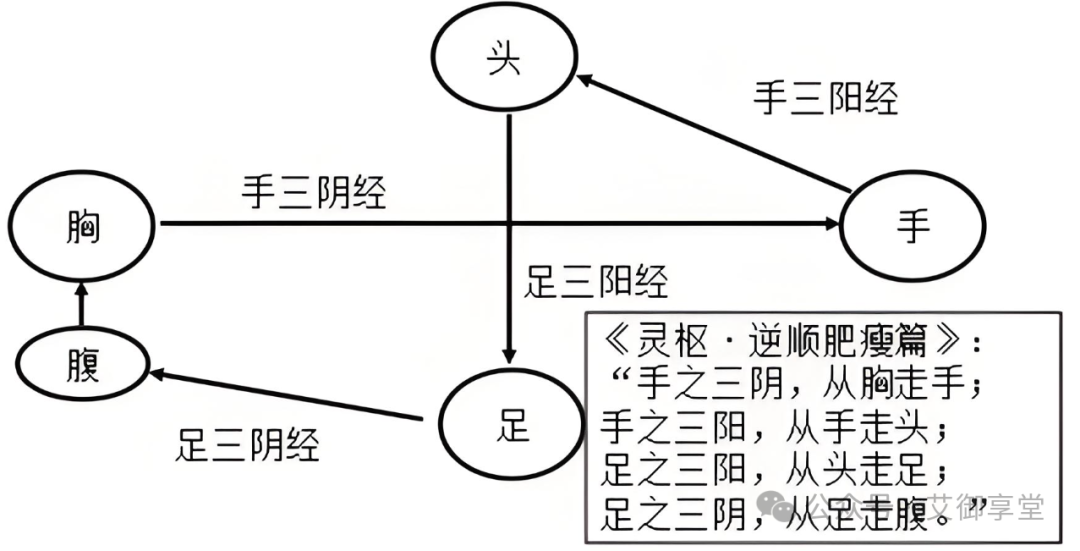
Regarding the distribution patterns of the twelve meridians in the trunk, a question arises: the meridians running along the abdominal surface are quite abundant, specifically among the twelve meridians, there are four: the Foot Yangming Stomach Meridian and the Foot Three Yin meridians. Is there an arrangement order for these four meridians in the abdomen? There is indeed a pattern. First, we must mention the midline of the chest and abdomen, which is an anatomical standard. The meridian running along the midline of the chest and abdomen is the Ren Meridian, known as the “sea of Yin meridians,” which can regulate and integrate all Yin meridians. The four meridians arranged outward from the Ren Meridian are: Kidney Meridian, Stomach Meridian, Spleen Meridian, and Liver Meridian. The Foot Shaoyin Kidney Meridian is closest to the midline, specifically located 2 cun from the midline in the chest and 0.5 cun from the midline in the abdomen; next is the Foot Yangming Stomach Meridian, specifically located 4 cun from the midline in the chest, passing through the center of the nipple, and 2 cun from the midline in the abdomen; then outward in order are the Foot Taiyin Spleen Meridian and the Foot Jueyin Liver Meridian. The distribution patterns of the twelve meridians in the trunk can be summarized in the table below.
The content of this article is for reference only,and is not intended for non-professionaldoctors to attempt acupuncture or medication.

